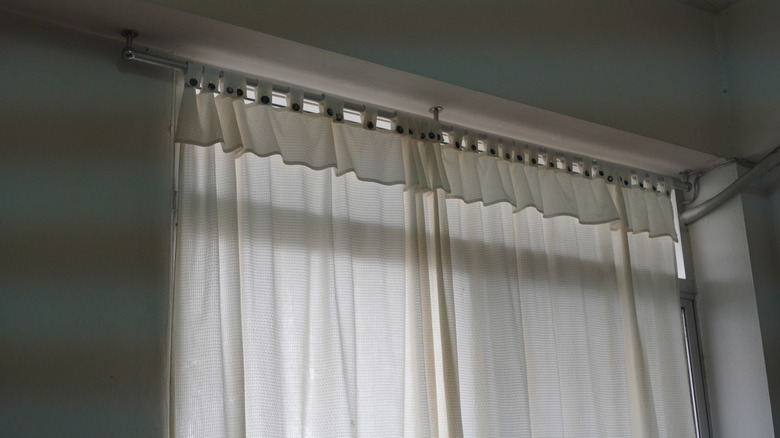Thick Vs. Thin Curtain Rods: How To Choose Which Is Best For Your Home
You've settled on curtains for your window coverings, and now you face another choice before you can hang them up: thick curtain rods or thin ones? Just like pizza crusts, curtain rods come in varying thicknesses — and whether you choose thick or thin is largely a matter of personal preference, although a few more practical considerations also factor into the curtain rod choice.
The thickness of curtain rods refers to their diameter, the distance across the widest point. Measured in inches, curtain rod diameters can range from less than an inch up to 3 inches wide. In general, common diameters for pre-made wooden curtain rods range from ½ inch to 3 inches, while pre-made metal curtain rods range from 1-⅜ inch to 2 inches in diameter. You can, however, also order custom curtain rods where you specify both the diameter and the length. Curtain rods come in both fixed length and telescoping versions, where they expand from a minimum to a maximum length, with some typical lengths ranging from a rod that telescopes from 28 to 48 inches to one that telescopes from 120 to 170 inches.
You determine the size you need by measuring the width of your window, using either the inner casing or the outer frame as your border, and generally adding 6 inches to both sides of this measurement to allow the curtains to move over the window frame. HGTV's Emily Henderson has a handy rule when you're making this choice regarding your curtain rod.
Thick curtain rods tend to be stronger
Thick curtain rods generally have increased strength to go with their increased diameter. This makes them a good choice for curtains or drapes made from more heavily weighted fabric. If you choose such fabric and don't get a curtain rod that can stand up to it, your curtain rod can eventually bend or break from the curtain's weight. Manufactured curtain rods are made from materials that include wood and a variety of metals, such as wrought iron or stainless steel, as well as plastic or aluminum. You can also DIY curtain rods, but you should still keep their weight-bearing capacity for your chosen curtains in mind. In general, wood curtain rods come in thicker diameters, while metal ones have the capacity to be thinner.
Besides their strength, thick curtain rods can also work well in rooms with high ceilings, where their larger diameter means they're proportionally more in balance with the larger space. You may also want to keep the size of your windows — and of the rest of the furniture in the room — in mind when considering the best scale for the size of your curtain rods. Since bigger is often bolder, thicker curtain rods may also work well for you if your decorating style tends towards big statements or a traditional aesthetic.
Thin curtain rods can work with light fabrics and small spaces
Thin curtain rods, on the other hand, can fit in well with a modern or minimalist style of decorating. They can also work well (without overwhelming the area) in rooms with low ceilings or smaller spaces in general. In addition to providing a lighter look, thin curtain rods are a fine choice to support curtains or drapes made out of lighter weight materials, such as sheer curtains. In addition to the practical matter of which diameter curtain rod will support the weight of your curtain, you'll also want to consider the visual harmony between a thick or thin curtain rod and the style of your drapes. Another factor to remember when choosing the thickness of your curtain rod is that it needs to be able to fit into the fabric opening in the curtain hem or tabs.
While you can match the style or color of your curtain rods throughout your house, there's no rule that requires you to do so. If you're stuck on the choice between thick or thin curtain rods, you may want to mix it up throughout your home, just as you might try mixing your curtain styles. Or, in some cases, you may just want to install your curtains without a curtain rod at all.


